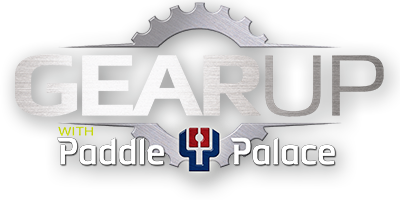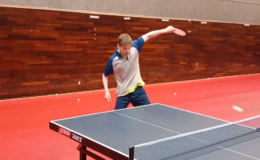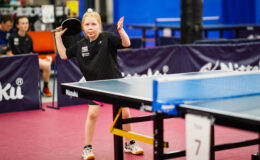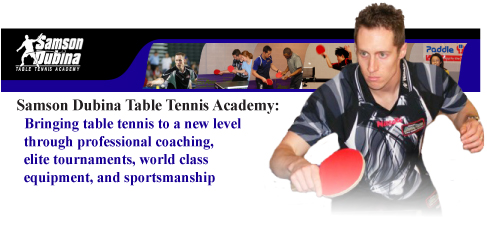
Fix It or Trash It
By Coach Samson Dubina
In every match, you will miss some shots. When you miss a particular shot in table tennis, what do you do? Do you adjust your particular shot or do you stop doing that particular shot?
Let me illustrate…
You are a two-winged looper rated 2207. You are playing against your main rival rated 2190. In the beginning of a match, your opponent pushes long to your backhand, and you loop the ball in the bottom of the net. He does it again and again and again and you continue to loop the ball in the bottom of the net again and again. You now see yourself down 0-4 in the first game and wonder what to do. What should you do? Hmmmmm…..Fix It or Trash It?!?!
In order to fix it, you first must understand the problem. You are looping into the net and the ball needs to clear the net. You might choose to open your angle, start your racket lower, use your legs more, contact the ball in a different position, swing more vertically, or use more spin. By choosing any of these options, you might be able to fix the problem. In order to trash it, you need to have an alternative stroke that will replace it. Some options for replacing your backhand loop against backspin would be to pivot and use your forehand loop from the backhand side or just merely push the ball back to a good location. In this scenario, it is critical that you make the right choice – fix it or trash it. If you choose to trash it, you must also consider changing the game patterns so that you can somewhat hide your weak point. If you don’t want someone pushing wide to your backhand, then consider serving sidespin wide to your opponent’s forehand; this will make it a bit more challenging to push the sharp angle to your wide backhand. Or, better yet, serve short topspin. The majority of short topspin serves will be flipped, which might play perfectly into your fast topspin game allowing you to eliminate the sharp push to your backhand when you are serving.
So what are the specific rules here? When should you fix a stroke (by making adjustments) and when should you trash a stroke (by choosing an alternative)?
The “Fix It” Rule
I would recommend fixing a particular stroke when it is a core aspect of winning. Let’s examine one of your previous matches… In last tournament, you were in the finals of the u2100 event. Your opponent kept serving long. If you blocked or pushed his serve, he followed-up with a deadly smash. When you tried to loop the serve, you were missing most of your loops long against his heavy sidespin-topspin long serve. Fix it or trash it? If you trashed it, your alternatives of pushing and blocking didn’t work against this opponent. You decided to be persistent at looping the long serve. It didn’t work for the first game and a half. You lost the first game 11-5 and were down 8-4 in the second before you realized how to adjust with your body position, adjust your distance from the table, adjust your racket’s starting position, and adjust your racket angle. After being down 8-4 in the second, your adjustments paid off and you swept your opponent -5, 9, 6, 3. Good choice at being persistent and making good adjustments!!!
The “Trash It” Rule
I would recommend trashing a particular stroke for that match if it isn’t a core aspect of your game.You are a forehand looper with excellent speed, spin, control, and placement; and you have great footwork. You have recently started experimenting with your backhand loop and had some success at the club during the last three month. Last Saturday, you were in the finals of the u2300 and playing against a chopper. You missed a few backhand loops, then decided to trash it and use only forehand. Good choice! When playing against this particular chopper, you had plenty of time to use all forehand. You realized that he was counting on your unforced errors to win the match. By trashing your backhand loop and using all forehand, you were able to play very consistently and dominate using your strong forehand.
Homework Assignment:
I want you to take out a pen and paper. Think deeply about what aspects of your game are important and also think about what aspects of your game are optional.
- List the ways that you prefer to serve with different variations: type of serve, type of spin, amount of spin, and ball placement
- List the ways that you prefer to return serve with different variations: active attacking returns and passive safe returns
- List the ways that you prefer to use your forehand and backhand loops: against topspin and backspin, down-the-line and crosscourt, with heavy spin and sidespin and no spin variations
- List the ways that you prefer to play the short game: flips, drop shot, deep push, banana flip, angled pushes, and sidespin pushes.
- List the ways that you prefer to end points: with a flipkill, with a flat smash, with a topspin smash, with a wide-angled loop, with a consistent rally, with a well-placed block
Once you have made a good summary of your own game and understand the core elements of your game, you will then be able to make decisions during a match.
Hmmmmmm… Should I FIX IT OR TRASH IT?
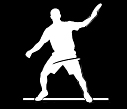 I would recommend fixing a particular stroke when it is a core aspect of winning. Let’s examine one of your previous matches… In last tournament, you were in the finals of the u2100 event. Your opponent kept serving long. If you blocked or pushed his serve, he followed-up with a deadly smash. When you tried to loop the serve, you were missing most of your loops long against his heavy sidespin-topspin long serve. Fix it or trash it?
I would recommend fixing a particular stroke when it is a core aspect of winning. Let’s examine one of your previous matches… In last tournament, you were in the finals of the u2100 event. Your opponent kept serving long. If you blocked or pushed his serve, he followed-up with a deadly smash. When you tried to loop the serve, you were missing most of your loops long against his heavy sidespin-topspin long serve. Fix it or trash it?
